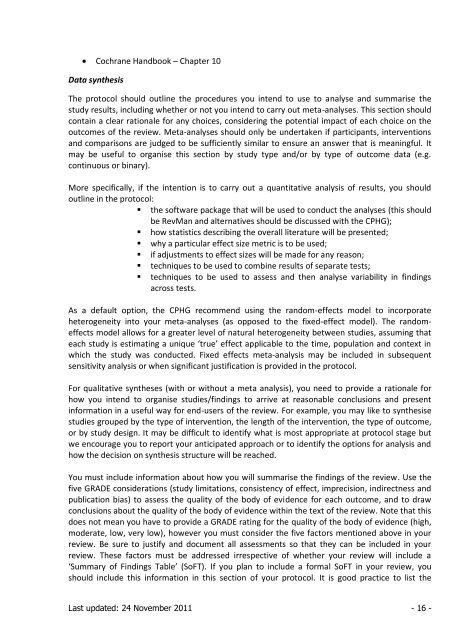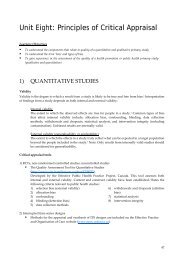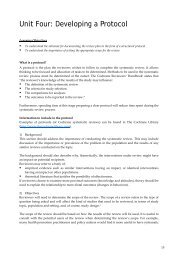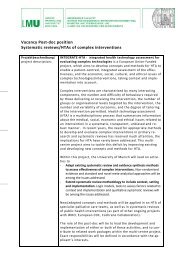Guide for Developing a Cochrane Protocol - Cochrane Public Health ...
Guide for Developing a Cochrane Protocol - Cochrane Public Health ...
Guide for Developing a Cochrane Protocol - Cochrane Public Health ...
Create successful ePaper yourself
Turn your PDF publications into a flip-book with our unique Google optimized e-Paper software.
<strong>Cochrane</strong> Handbook – Chapter 10<br />
Data synthesis<br />
The protocol should outline the procedures you intend to use to analyse and summarise the<br />
study results, including whether or not you intend to carry out meta-analyses. This section should<br />
contain a clear rationale <strong>for</strong> any choices, considering the potential impact of each choice on the<br />
outcomes of the review. Meta-analyses should only be undertaken if participants, interventions<br />
and comparisons are judged to be sufficiently similar to ensure an answer that is meaningful. It<br />
may be useful to organise this section by study type and/or by type of outcome data (e.g.<br />
continuous or binary).<br />
More specifically, if the intention is to carry out a quantitative analysis of results, you should<br />
outline in the protocol:<br />
• the software package that will be used to conduct the analyses (this should<br />
be RevMan and alternatives should be discussed with the CPHG);<br />
• how statistics describing the overall literature will be presented;<br />
• why a particular effect size metric is to be used;<br />
• if adjustments to effect sizes will be made <strong>for</strong> any reason;<br />
• techniques to be used to combine results of separate tests;<br />
• techniques to be used to assess and then analyse variability in findings<br />
across tests.<br />
As a default option, the CPHG recommend using the random-effects model to incorporate<br />
heterogeneity into your meta-analyses (as opposed to the fixed-effect model). The randomeffects<br />
model allows <strong>for</strong> a greater level of natural heterogeneity between studies, assuming that<br />
each study is estimating a unique ‘true’ effect applicable to the time, population and context in<br />
which the study was conducted. Fixed effects meta-analysis may be included in subsequent<br />
sensitivity analysis or when significant justification is provided in the protocol.<br />
For qualitative syntheses (with or without a meta analysis), you need to provide a rationale <strong>for</strong><br />
how you intend to organise studies/findings to arrive at reasonable conclusions and present<br />
in<strong>for</strong>mation in a useful way <strong>for</strong> end-users of the review. For example, you may like to synthesise<br />
studies grouped by the type of intervention, the length of the intervention, the type of outcome,<br />
or by study design. It may be difficult to identify what is most appropriate at protocol stage but<br />
we encourage you to report your anticipated approach or to identify the options <strong>for</strong> analysis and<br />
how the decision on synthesis structure will be reached.<br />
You must include in<strong>for</strong>mation about how you will summarise the findings of the review. Use the<br />
five GRADE considerations (study limitations, consistency of effect, imprecision, indirectness and<br />
publication bias) to assess the quality of the body of evidence <strong>for</strong> each outcome, and to draw<br />
conclusions about the quality of the body of evidence within the text of the review. Note that this<br />
does not mean you have to provide a GRADE rating <strong>for</strong> the quality of the body of evidence (high,<br />
moderate, low, very low), however you must consider the five factors mentioned above in your<br />
review. Be sure to justify and document all assessments so that they can be included in your<br />
review. These factors must be addressed irrespective of whether your review will include a<br />
‘Summary of Findings Table’ (SoFT). If you plan to include a <strong>for</strong>mal SoFT in your review, you<br />
should include this in<strong>for</strong>mation in this section of your protocol. It is good practice to list the<br />
Last updated: 24 November 2011 - 16 -








